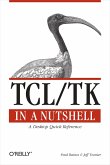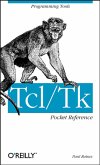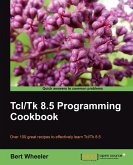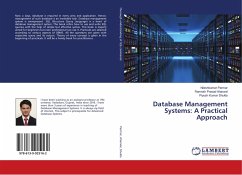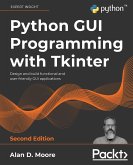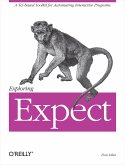The classic bestseller on Tcl/Tk — and the most complete reference — has been updated to version 8.4.
Previous edition sold over 20,000 copies domestically - 30,000 worldwide.
Updated for Tcl/Tk 8.4-comprehensive and accurate coverage of every Tcl and Tk command.
CD-ROM includes all code plus binary distributions of Tcl/Tk, Tcl extentions and tools.
Practical Programming in Tcl/Tk is described as the "bible" for Tcl programmers. It is a guide to the Tcl/Tk programming language and GUI toolkit. This revision includes substantial updates to cover the new version 8.4-giving both an overview of the features, as well as details about every command in the language. The third edition, written on version 8.2, sold over 30,000 copies. Version 8.4 of Tcl - Tool Command Language-provides substantial updates to one of the most popular UNIX scripting languages. The latest release, includes the addition of a virtual filesystem (VFS), many additional programming widgets (spinbox, panedwindow, labelframe),and improved performance of about 20% over 8.3. The book provides a guide to the best ways to use the tooklit. It not only gives accurate details, but includes extensive examples that demonstrate the best way to use the toolkit. The authors are experts that have both developed the technology and used it to solve problems, so they have many valuable insights to relate to the readers. Brent Welch is a software architect at Panasas, and former research engineer at Sun Microsystems and Xerox PARC. He has been involved in Tcl and Tk from the early beginnings, and developed major Tcl applications including the exmh email user interface and the TclHttpd web server. His home page is http://www.beedub.com/ Ken Jones is a Silicon Valley Tcl/Tk instructor and frequent speaker at industry Tcl/Tk conferences. Product Description
Practical Programming in Tcl/Tk is described as the bible for Tcl programmers. It is a guide to the Tcl/Tk programming language and GUI toolkit. This revision includes substantial updates to cover the new version 8.4-giving both an overview of the features, as well as details about every command in the language. The third edition, written on version 8.2, sold over 30,000 copies. Version 8.4 of Tcl - Tool Command Language-provides substantial updates to one of the most popular UNIX scripting languages. The latest release, includes the addition of a virtual filesystem (VFS), many additional programming widgets (spinbox, panedwindow, labelframe),and improved performance of about 20% over 8.3. The book provides a guide to the best ways to use the tooklit. It not only gives accurate details, but includes extensive examples that demonstrate the best way to use the toolkit. The authors are experts that have both developed the technology and used it to solve problems, so they have many valuable insights to relate to the readers.
Features + Benefits
The classic bestseller on Tcl/Tk -- and the most complete reference -- has been updated to version 8.4!
° Previous edition sold over 20,000 copies domestically - 30,000 worldwide!
° Updated for Tcl/Tk 8.4-comprehensive and accurate coverage of every Tcl and Tk command
° CD-ROM includes all code plus binary distributions of Tcl/Tk, Tcl extentions and tools
Backcover
Practical Programming in Tcl/Tk, 4th edition
The Tcl/Tk bestseller fully updated for Tcl 8.4!
Authoritative coverage of every Tcl and Tk command in the core toolkits
State-of-the-art Tk GUI coverage for Tcl, Perl, Python, and Ruby developers
Covers all key Tcl 8.4 enhancements: VFS, internationalization and performance improvements, new widgets, and much more
Covers multi-threaded Tcl applications and Starkits, a revolutionary way to package and deploy Tcl applications
CD-ROM: Source and binary Tcl/Tk distributions and extensions for Windows®, LinuxT, SolarisT, and Macintosh®, plus all code from the book
The Tcl/Tk bestseller, now completely updated for Tcl 8.4!
The world's #1 guide to Tcl/Tk has been thoroughly updated to reflect Tcl/Tk8.4's powerful improvements in functionality, flexibility, and performance!Brent Welch, Ken Jones, and Jeffrey Hobbs, three of the world1s leading Tcl/Tk experts, cover every facet of Tcl/Tk programming, including cross-platform scripting and GUI development, networking, enterprise application integration, and much more.Coverage includes:
Systematic explanations and sample code for all Tcl/Tk 8.4 core commands
Complete Tk GUI development guidance--perfect for developers working with Perl, Python, or Ruby
Insider's insights into Tcl 8.4's key enhancements: VFS layer, internationalized font/character set support, new widgets, and more
Definitive coverage of TclHttpd web server--written by its creator
New ways to leverage Tcl/Tk 8.4's major performance improvements
Advanced coverage: threading, Safe Tcl, Tcl script library, regular expressions, and namespaces
Whether you1re upgrading to Tcl/Tk 8.4, or building GUIs for applicationscreated with other languages, or just searching for a better cross-platformscripting solution, Practical Programming in Tcl and Tk, Fourth Editiondelivers all you need to get results!
The accompanying CD-ROM includes source and binary distributionsof Tcl/Tk, Tcl extensions, and tools for Windows 9x/2000/XP, Linux, Solaris,and Macintosh, plus all the code from the book.
List of Examples.
List of Tables.
Preface.
I. Tcl BASICS.
1. Tcl Fundamentals.
Tcl Commands. Hello, World! Variables. Command Substitution. Math Expressions. Backslash Substitution. Grouping with Braces and Double Quotes. Procedures. A Factorial Example. More about Variables. More about Math Expressions. Comments. Substitution and Grouping Summary. Fine Points. Reference.
2. Getting Started.
The source Command. UNIX Tcl Scripts. Windows Start Menu. Macintosh OS 8/9 and ResEdit. The console Command. Command-Line Arguments. Predefined Variables.
3. The Guestbook CGI Application.
A Quick Introduction to HTML. CGI for Dynamic Pages. The guestbook.cgi Script. Defining Forms and Processing Form Data. Handling Errors in CGI Scripts. Next Steps.
4. String Processing in Tcl.
The string Command. The append Command. The format Command. The scan Command. The binary Command. Related Chapters.
5. Tcl Lists.
Tcl Lists. Constructing Lists. Getting List Elements: llength, lindex, and lrange. Modifying Lists: linsert and lreplace. Searching Lists: lsearch. Sorting Lists: lsort. The split Command. The join Command. Related Chapters.
6. Control Structure Commands.
If Then Else. Switch. While. Foreach. For. Break and Continue. Catch. Error. Return.
7. Procedures and Scope.
The proc Command. Changing Command Names with rename. Scope. The global Command. Call by Name Using upvar. Variable Aliases with upvar.
8. Tcl Arrays.
Array Syntax. The array Command. Building Data Structures with Arrays.
9. Working with Files and Programs.
Running Programs with exec. The file Command. Cross-Platform File Naming. Manipulating Files and Directories. File Attributes. Input/Output Command Summary. Opening Files for I/O. Reading and Writing. The Current Directory - cd and pwd. Matching File Names with glob. The exit and pid Commands. Environment Variables. The registry Command.
II. ADVANCED Tcl.
10. Quoting Issues and Eval.
Constructing Code with the list Command. Exploiting the concat inside eval. The uplevel Command. The subst Command.
11. Regular Expressions.
When to Use Regular Expressions. Regular Expression Syntax. Advanced Regular Expressions. Syntax Summary. The regexp Command. The regsub Command. Transforming Data to Program with regsub. Other Commands That Use Regular Expressions.
12. Script Libraries and Packages.
Locating Packages: The auto_path Variable. Using Packages. Summary of Package Loading. The package Command. Libraries Based on the tclIndex File. The unknown Command. Interactive Conveniences. Tcl Shell Library Environment. Coding Style.
13. Reflection and Debugging.
The clock Command. The info Command. Cross-Platform Support. Tracing Variables and Commands. Interactive Command History. Debugging. Tcl Dev Kit. Other Tools. Performance Tuning.
14. Namespaces.
Using Namespaces. Namespace Variables. Command Lookup. Nested Namespaces. Importing and Exporting Procedures. Callbacks and Namespaces. Introspection. The namespace Command. Converting Existing Packages to use Namespaces. [incr Tcl] Object System. xotcl Object System. Notes.
15. Internationalization.
Character Sets and Encodings. Message Catalogs.
16. Event-Driven Programming.
The Tcl Event Loop. The after Command. The fileevent Command. The vwait Command. The fconfigure Command.
17. Socket Programming.
Networking Extensions for Tcl. Client Sockets. Server Sockets. The Echo Service. Fetching a URL with HTTP. The http Package. Basic Authentication.
18. TclHttpd Web Server.
Integrating TclHttpd with Your Application. Domain Handlers. Application Direct URLs. Document Types. HTML + Tcl Templates. Form Handlers. Programming Reference. Standard Application Direct URLs. The TclHttpd Distribution. Server Configuration.
19. Multiple Interpreters and Safe-Tcl.
The interp Command. Creating Interpreters. Safe Interpreters. Command Aliases. Hidden Commands. Substitutions. I/O from Safe Interpreters. The Safe Base. Security Policies.
20. Safe-Tk and the Browser Plugin.
Tk in Child Interpreters. The Browser Plugin. Security Policies and Browser Plugin. Configuring Security Policies.
21. Multi-Threaded Tcl Scripts.
What are Threads? Thread Support in Tcl. Getting Started with the Thread Extension. Sending Messages to Threads. Preserving and Releasing Threads. Error Handling. Shared Resources. Managing I/O Channels. Shared Variables. Mutexes and Condition Variables. Thread Pools. The Thread Package Commands.
22. Tclkit and Starkits.
Getting Started with Tclkit. Virtual File Systems. Using sdx to Bundle Applications. Exploring the Virtual File System in a Starkit. Creating tclhttpd.kit. Creating a Shared Starkit. Metakit. More Ideas.
III. Tk BASICS.
23. Tk Fundamentals.
Hello, World! in Tk. Naming Tk Widgets. Configuring Tk Widgets. Tk Widget Attributes and the Resource Database. Summary of the Tk Commands. Other Widget Sets.
24. Tk by Example.
ExecLog. The Example Browser. A Tcl Shell.
25. The Pack Geometry Manager.
Packing toward a Side. Horizontal and Vertical Stacking. The Cavity Model. Packing Space and Display Space. Resizing and -expand. Anchoring. Packing Order. Choosing the Parent for Packing. Unpacking a Widget. Packer Summary. Window Stacking Order.
26. The Grid Geometry Manager.
A Basic Grid. Spanning Rows and Columns. Row and Column Constraints. The grid Command.
27. The Place Geometry Manager.
place Basics. The Pane Manager. The place Command.
28. The Panedwindow Widget.
Using the Panedwindow. Programming Panedwindow Widgets. Panedwindow Attributes.
29. Binding Commands to Events.
The bind Command. The bindtags Command. Event Syntax. Modifiers. Event Sequences. Virtual Events. Generating Events. Event Summary.
IV. Tk Widgets.
30. Buttons and Menus.
Button Commands and Scope Issues. Buttons Associated with Tcl Variables. Button Attributes. Button Operations. Menus and Menubuttons. Menu Bindings and Events. Manipulating Menus and Menu Entries. Menu Attributes. A Menu by Name Package.
31. The Resource Database.
An Introduction to Resources. Loading Option Database Files. Adding Individual Database Entries. Accessing the Database. User-Defined Buttons. User-Defined Menus.
32. Simple Tk Widgets.
Frames, Labelframes, and Toplevel Windows. The Label Widget. The Message Widget. The Scale Widget. The bell Command.
33. Scrollbars.
Using Scrollbars. The Scrollbar Protocol. The Scrollbar Widget.
34. The Entry and Spinbox Widgets.
Using Entry Widgets. Using Spinbox Widgets. Entry and Spinbox Bindings. Entry and Spinbox Attributes. Programming Entry and Spinbox Widgets.
35. The Listbox Widget.
Using Listboxes. The Listbox Widget. Listbox Bindings and Events. Listbox Attributes.
36. The Text Widget.
Text Indices. Text Marks. Text Tags. The Selection.Tag Bindings. Searching Text. Embedded Widgets. Embedded Images. Looking inside the Text Widget. The Undo Mechanism. Text Bindings and Events. Text Operations. Text Attributes.
37. The Canvas Widget.
Canvas Coordinates. Hello, World! The Min Max Scale Example. Canvas Objects
Appropriate for all courses in Tcl/Tk scripting, and many courses in Unix shell scripting.
Practical Programming in Tcl/Tk, Fourth Edition is the definitive guide to Tcl/Tk programming for developers at all levels
Previous edition sold over 20,000 copies domestically - 30,000 worldwide.
Updated for Tcl/Tk 8.4-comprehensive and accurate coverage of every Tcl and Tk command.
CD-ROM includes all code plus binary distributions of Tcl/Tk, Tcl extentions and tools.
Practical Programming in Tcl/Tk is described as the "bible" for Tcl programmers. It is a guide to the Tcl/Tk programming language and GUI toolkit. This revision includes substantial updates to cover the new version 8.4-giving both an overview of the features, as well as details about every command in the language. The third edition, written on version 8.2, sold over 30,000 copies. Version 8.4 of Tcl - Tool Command Language-provides substantial updates to one of the most popular UNIX scripting languages. The latest release, includes the addition of a virtual filesystem (VFS), many additional programming widgets (spinbox, panedwindow, labelframe),and improved performance of about 20% over 8.3. The book provides a guide to the best ways to use the tooklit. It not only gives accurate details, but includes extensive examples that demonstrate the best way to use the toolkit. The authors are experts that have both developed the technology and used it to solve problems, so they have many valuable insights to relate to the readers. Brent Welch is a software architect at Panasas, and former research engineer at Sun Microsystems and Xerox PARC. He has been involved in Tcl and Tk from the early beginnings, and developed major Tcl applications including the exmh email user interface and the TclHttpd web server. His home page is http://www.beedub.com/ Ken Jones is a Silicon Valley Tcl/Tk instructor and frequent speaker at industry Tcl/Tk conferences. Product Description
Practical Programming in Tcl/Tk is described as the bible for Tcl programmers. It is a guide to the Tcl/Tk programming language and GUI toolkit. This revision includes substantial updates to cover the new version 8.4-giving both an overview of the features, as well as details about every command in the language. The third edition, written on version 8.2, sold over 30,000 copies. Version 8.4 of Tcl - Tool Command Language-provides substantial updates to one of the most popular UNIX scripting languages. The latest release, includes the addition of a virtual filesystem (VFS), many additional programming widgets (spinbox, panedwindow, labelframe),and improved performance of about 20% over 8.3. The book provides a guide to the best ways to use the tooklit. It not only gives accurate details, but includes extensive examples that demonstrate the best way to use the toolkit. The authors are experts that have both developed the technology and used it to solve problems, so they have many valuable insights to relate to the readers.
Features + Benefits
The classic bestseller on Tcl/Tk -- and the most complete reference -- has been updated to version 8.4!
° Previous edition sold over 20,000 copies domestically - 30,000 worldwide!
° Updated for Tcl/Tk 8.4-comprehensive and accurate coverage of every Tcl and Tk command
° CD-ROM includes all code plus binary distributions of Tcl/Tk, Tcl extentions and tools
Backcover
Practical Programming in Tcl/Tk, 4th edition
The Tcl/Tk bestseller fully updated for Tcl 8.4!
Authoritative coverage of every Tcl and Tk command in the core toolkits
State-of-the-art Tk GUI coverage for Tcl, Perl, Python, and Ruby developers
Covers all key Tcl 8.4 enhancements: VFS, internationalization and performance improvements, new widgets, and much more
Covers multi-threaded Tcl applications and Starkits, a revolutionary way to package and deploy Tcl applications
CD-ROM: Source and binary Tcl/Tk distributions and extensions for Windows®, LinuxT, SolarisT, and Macintosh®, plus all code from the book
The Tcl/Tk bestseller, now completely updated for Tcl 8.4!
The world's #1 guide to Tcl/Tk has been thoroughly updated to reflect Tcl/Tk8.4's powerful improvements in functionality, flexibility, and performance!Brent Welch, Ken Jones, and Jeffrey Hobbs, three of the world1s leading Tcl/Tk experts, cover every facet of Tcl/Tk programming, including cross-platform scripting and GUI development, networking, enterprise application integration, and much more.Coverage includes:
Systematic explanations and sample code for all Tcl/Tk 8.4 core commands
Complete Tk GUI development guidance--perfect for developers working with Perl, Python, or Ruby
Insider's insights into Tcl 8.4's key enhancements: VFS layer, internationalized font/character set support, new widgets, and more
Definitive coverage of TclHttpd web server--written by its creator
New ways to leverage Tcl/Tk 8.4's major performance improvements
Advanced coverage: threading, Safe Tcl, Tcl script library, regular expressions, and namespaces
Whether you1re upgrading to Tcl/Tk 8.4, or building GUIs for applicationscreated with other languages, or just searching for a better cross-platformscripting solution, Practical Programming in Tcl and Tk, Fourth Editiondelivers all you need to get results!
The accompanying CD-ROM includes source and binary distributionsof Tcl/Tk, Tcl extensions, and tools for Windows 9x/2000/XP, Linux, Solaris,and Macintosh, plus all the code from the book.
List of Examples.
List of Tables.
Preface.
I. Tcl BASICS.
1. Tcl Fundamentals.
Tcl Commands. Hello, World! Variables. Command Substitution. Math Expressions. Backslash Substitution. Grouping with Braces and Double Quotes. Procedures. A Factorial Example. More about Variables. More about Math Expressions. Comments. Substitution and Grouping Summary. Fine Points. Reference.
2. Getting Started.
The source Command. UNIX Tcl Scripts. Windows Start Menu. Macintosh OS 8/9 and ResEdit. The console Command. Command-Line Arguments. Predefined Variables.
3. The Guestbook CGI Application.
A Quick Introduction to HTML. CGI for Dynamic Pages. The guestbook.cgi Script. Defining Forms and Processing Form Data. Handling Errors in CGI Scripts. Next Steps.
4. String Processing in Tcl.
The string Command. The append Command. The format Command. The scan Command. The binary Command. Related Chapters.
5. Tcl Lists.
Tcl Lists. Constructing Lists. Getting List Elements: llength, lindex, and lrange. Modifying Lists: linsert and lreplace. Searching Lists: lsearch. Sorting Lists: lsort. The split Command. The join Command. Related Chapters.
6. Control Structure Commands.
If Then Else. Switch. While. Foreach. For. Break and Continue. Catch. Error. Return.
7. Procedures and Scope.
The proc Command. Changing Command Names with rename. Scope. The global Command. Call by Name Using upvar. Variable Aliases with upvar.
8. Tcl Arrays.
Array Syntax. The array Command. Building Data Structures with Arrays.
9. Working with Files and Programs.
Running Programs with exec. The file Command. Cross-Platform File Naming. Manipulating Files and Directories. File Attributes. Input/Output Command Summary. Opening Files for I/O. Reading and Writing. The Current Directory - cd and pwd. Matching File Names with glob. The exit and pid Commands. Environment Variables. The registry Command.
II. ADVANCED Tcl.
10. Quoting Issues and Eval.
Constructing Code with the list Command. Exploiting the concat inside eval. The uplevel Command. The subst Command.
11. Regular Expressions.
When to Use Regular Expressions. Regular Expression Syntax. Advanced Regular Expressions. Syntax Summary. The regexp Command. The regsub Command. Transforming Data to Program with regsub. Other Commands That Use Regular Expressions.
12. Script Libraries and Packages.
Locating Packages: The auto_path Variable. Using Packages. Summary of Package Loading. The package Command. Libraries Based on the tclIndex File. The unknown Command. Interactive Conveniences. Tcl Shell Library Environment. Coding Style.
13. Reflection and Debugging.
The clock Command. The info Command. Cross-Platform Support. Tracing Variables and Commands. Interactive Command History. Debugging. Tcl Dev Kit. Other Tools. Performance Tuning.
14. Namespaces.
Using Namespaces. Namespace Variables. Command Lookup. Nested Namespaces. Importing and Exporting Procedures. Callbacks and Namespaces. Introspection. The namespace Command. Converting Existing Packages to use Namespaces. [incr Tcl] Object System. xotcl Object System. Notes.
15. Internationalization.
Character Sets and Encodings. Message Catalogs.
16. Event-Driven Programming.
The Tcl Event Loop. The after Command. The fileevent Command. The vwait Command. The fconfigure Command.
17. Socket Programming.
Networking Extensions for Tcl. Client Sockets. Server Sockets. The Echo Service. Fetching a URL with HTTP. The http Package. Basic Authentication.
18. TclHttpd Web Server.
Integrating TclHttpd with Your Application. Domain Handlers. Application Direct URLs. Document Types. HTML + Tcl Templates. Form Handlers. Programming Reference. Standard Application Direct URLs. The TclHttpd Distribution. Server Configuration.
19. Multiple Interpreters and Safe-Tcl.
The interp Command. Creating Interpreters. Safe Interpreters. Command Aliases. Hidden Commands. Substitutions. I/O from Safe Interpreters. The Safe Base. Security Policies.
20. Safe-Tk and the Browser Plugin.
Tk in Child Interpreters. The Browser Plugin. Security Policies and Browser Plugin. Configuring Security Policies.
21. Multi-Threaded Tcl Scripts.
What are Threads? Thread Support in Tcl. Getting Started with the Thread Extension. Sending Messages to Threads. Preserving and Releasing Threads. Error Handling. Shared Resources. Managing I/O Channels. Shared Variables. Mutexes and Condition Variables. Thread Pools. The Thread Package Commands.
22. Tclkit and Starkits.
Getting Started with Tclkit. Virtual File Systems. Using sdx to Bundle Applications. Exploring the Virtual File System in a Starkit. Creating tclhttpd.kit. Creating a Shared Starkit. Metakit. More Ideas.
III. Tk BASICS.
23. Tk Fundamentals.
Hello, World! in Tk. Naming Tk Widgets. Configuring Tk Widgets. Tk Widget Attributes and the Resource Database. Summary of the Tk Commands. Other Widget Sets.
24. Tk by Example.
ExecLog. The Example Browser. A Tcl Shell.
25. The Pack Geometry Manager.
Packing toward a Side. Horizontal and Vertical Stacking. The Cavity Model. Packing Space and Display Space. Resizing and -expand. Anchoring. Packing Order. Choosing the Parent for Packing. Unpacking a Widget. Packer Summary. Window Stacking Order.
26. The Grid Geometry Manager.
A Basic Grid. Spanning Rows and Columns. Row and Column Constraints. The grid Command.
27. The Place Geometry Manager.
place Basics. The Pane Manager. The place Command.
28. The Panedwindow Widget.
Using the Panedwindow. Programming Panedwindow Widgets. Panedwindow Attributes.
29. Binding Commands to Events.
The bind Command. The bindtags Command. Event Syntax. Modifiers. Event Sequences. Virtual Events. Generating Events. Event Summary.
IV. Tk Widgets.
30. Buttons and Menus.
Button Commands and Scope Issues. Buttons Associated with Tcl Variables. Button Attributes. Button Operations. Menus and Menubuttons. Menu Bindings and Events. Manipulating Menus and Menu Entries. Menu Attributes. A Menu by Name Package.
31. The Resource Database.
An Introduction to Resources. Loading Option Database Files. Adding Individual Database Entries. Accessing the Database. User-Defined Buttons. User-Defined Menus.
32. Simple Tk Widgets.
Frames, Labelframes, and Toplevel Windows. The Label Widget. The Message Widget. The Scale Widget. The bell Command.
33. Scrollbars.
Using Scrollbars. The Scrollbar Protocol. The Scrollbar Widget.
34. The Entry and Spinbox Widgets.
Using Entry Widgets. Using Spinbox Widgets. Entry and Spinbox Bindings. Entry and Spinbox Attributes. Programming Entry and Spinbox Widgets.
35. The Listbox Widget.
Using Listboxes. The Listbox Widget. Listbox Bindings and Events. Listbox Attributes.
36. The Text Widget.
Text Indices. Text Marks. Text Tags. The Selection.Tag Bindings. Searching Text. Embedded Widgets. Embedded Images. Looking inside the Text Widget. The Undo Mechanism. Text Bindings and Events. Text Operations. Text Attributes.
37. The Canvas Widget.
Canvas Coordinates. Hello, World! The Min Max Scale Example. Canvas Objects
Appropriate for all courses in Tcl/Tk scripting, and many courses in Unix shell scripting.
Practical Programming in Tcl/Tk, Fourth Edition is the definitive guide to Tcl/Tk programming for developers at all levels



